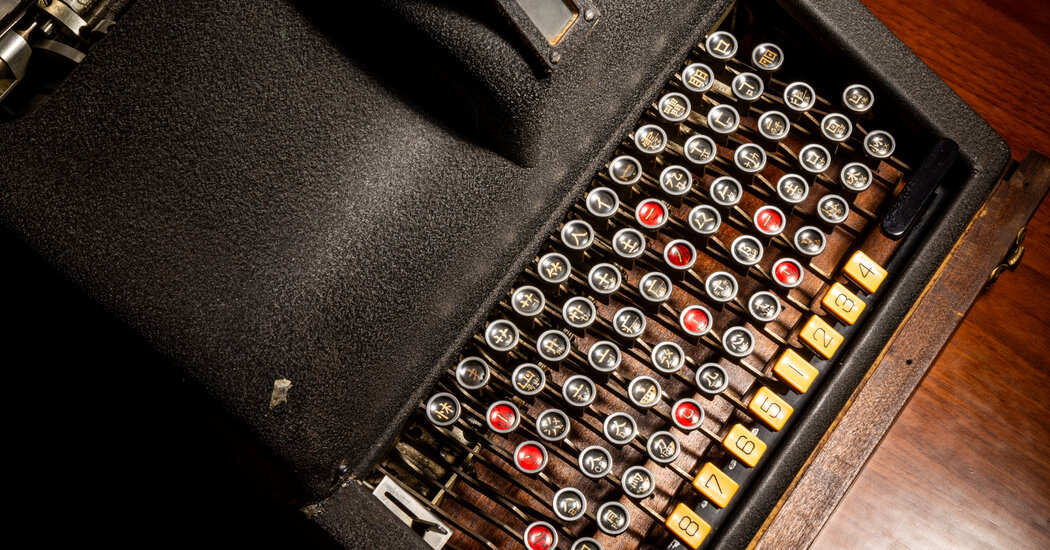In 2010, Tom Mullaney found himself way out in the suburbs of London. A woman there wanted to show him a Chinese typewriter. She was going to be renovating her house soon, she told him, and it needed a new home.
Dr. Mullaney, a professor of Chinese history at Stanford University, had spent years searching the globe for Chinese typewriters, wondrous machines capable of printing thousands of Chinese characters while remaining small enough to keep on a desk.
The typewriter, 50 pounds of metal frame and levers, was one of a dying breed. If he didn’t save it, would it wind up on a scrapheap?
It went into a suitcase and he took it back to California, where it joined a growing collection of Asian-language typing devices that he’d hunted down.
But there was one typewriter that Dr. Mullaney had little hope of ever finding: the MingKwai. Made by an eccentric Chinese linguist turned inventor living in Manhattan, the machine had mechanics that were a precursor to the systems almost everyone now uses to type in Chinese.
Only one — the prototype — was ever made.
“It was the one machine,” he said recently, “which despite all my cold-calling, all my stalking, was absolutely, 100 percent, definitely gone.”
Dr. Mullaney’s mania for clunky text appliances began in 2007, when he was preparing a talk on the disappearance of Chinese characters and found himself contemplating the disintegration of everything.
Among the vast number of characters in the Chinese language — around 100,000, by some estimates — there are hundreds that no one alive knows how to pronounce. They are written down, plain as day, in old books, but their sounds, even their meanings, have been lost.
Sitting in his office, wondering at how something seemingly immortalized in print could be forgotten, Dr. Mullaney went down a mental rabbit hole.
It would have been physically impossible to build a typing machine to include all the characters that were historically written out by hand, he thought. Some characters must have made the cut, while others were left behind. He sat back in his chair and asked himself: Could he recall ever having seen a Chinese typewriter?
Two hours later, he was lying on the floor of his office, looking at patent documents for such devices. There had been, over the last century and a half, dozens of different Chinese typewriters made. Each one was an inventor’s take on how to incorporate thousands of characters into a machine without making it unusable — a physical manifestation of their ideas about language. Never plentiful, the typewriters were now increasingly rare, gone the way of most obsolete technology.
Dr. Mullaney was fascinated.
That evening turned into months of research, which turned into years of searching, as Chinese typewriters became one of his areas of historical expertise.
He cold-called strangers and left voice mail messages for private collectors, people whom he suspected, from faint traces left on the internet, of having typewriters. He pored over Ancestry.com, looking for the next of kin of the last known owner of a particular machine. He called museums and asked, “Do you, by any chance, have a Chinese typewriter?”
Sometimes, they said yes. A private museum in Delaware happened to have a surviving IBM Chinese typewriter, of which only two or three were ever made. Someone at a Chinese Christian church in San Francisco got in touch with him to say they owned a typewriter that they were trying to get rid of. Dr. Mullaney took it off their hands.
Then there was the fellow in Northern California who had held on to two Japanese typewriters, as rare as the Chinese varieties, for some decades. “He looked at me and said, ‘Is your trunk big enough?’” Dr. Mullaney recalled. It was, just.
Dr. Mullaney took home those typewriters, and the typewriter in London and others like them, because it had begun to dawn on him that he might soon be one of the only people alive who knew what these machines were, who really understood their stories. He might be the last thing standing between these machines and oblivion.
The MingKwai is legendary among the handful of people who know about Chinese typewriters.
It was invented by Lin Yutang, a Chinese linguist and public intellectual who had begun to worry in the 1930s that without some way to convert ink-brush characters into easily reproduced text, China would be left behind technologically — perhaps destroyed at the hands of foreign powers.
Attempts to create typing machines usually stumbled over the problem of cramming a galaxy of characters into a single machine.
Mr. Lin’s solution was an ingenious system housed in what looked like a large Western typewriter. But when you tapped the keys, something remarkable happened.
Any two keystrokes, representing pieces of characters, moved gears within the machine. In a central window, which Mr. Lin called the Magic Eye, up to eight different characters containing those pieces then appeared, and the typist could select the right one.
Mr. Lin had made it possible to type tens of thousands of characters using 72 keys. It was almost as if, Dr. Mullaney said, Mr. Lin had invented a keyboard with a single key capable of typing the entire Roman alphabet.
He named his machine MingKwai, which roughly translates to “clear and fast.”
Mr. Lin, who was then living with his wife and children on Manhattan’s Upper East Side, hired a New York machinist firm to make a prototype, at enormous cost to himself. He presented that prototype in a demonstration to executives from Remington, the typewriter manufacturer.
It was a failure. The machine malfunctioned at a crucial moment.
Mr. Lin went bankrupt and the prototype was sold to Mergenthaler Linotype, a printing company in Brooklyn.
And that, as far as Dr. Mullaney had been able to find out, was the machine’s last known location. When Mergenthaler Linotype moved offices sometime in the 1950s, the machine disappeared.
In his 2017 book, “The Chinese Typewriter,” Dr. Mullaney wrote that he believed the MingKwai had most likely ended up on a scrapheap. The right person hadn’t been there to save it, to tell its story.
This past January, Jennifer and Nelson Felix were in their home in Massapequa, N.Y., going through boxes that had been in storage since Ms. Felix’s father died in Arizona five years before. They were looking at a wooden crate sitting among the cardboard boxes. “What’s this?” Ms. Felix asked her husband.
He’d had a peek in the crate back in Arizona. Oh, he said, it’s that typewriter.
She opened it, and realized it was not a typical typewriter. The symbols on the keys looked like Chinese. Mr. Felix, who often sold and bought items on Facebook, quickly found a group called “What’s My Typewriter Worth?” and posted some photos.
Then they set it aside and moved on to other things. An hour later, Mr. Felix checked on his post.
There were hundreds of comments, many written in Chinese. People kept tagging someone named Tom.
The couple looked at each other. “Who’s Tom?”
Dr. Mullaney was in Chicago to give a talk when his phone started going off — ping, ping, ping.
The small community of people he’d encountered in his long quest were sending up digital flares, urgently trying to get his attention.
As soon as he saw the post, he knew exactly what he was looking at. It was the MingKwai.
But he didn’t rejoice. He didn’t sigh with relief. He was gripped with fear.
What if they didn’t know what they had and sold it before he could get to it?
Someone could buy it with a click on eBay. They could make it into a coffee table. Take it apart and make steampunk earrings. It would be gone, just like that.
He posted a comment on Facebook, asking the poster to contact him right away. After a few frantic hours, he got a reply, and the next day he and the Felixes were on the phone.
He told them the MingKwai’s story. He said that while it was up to them what they did with it, he hoped they would consider selling it to a museum. He was afraid that if it were sold at auction, it would disappear, a trophy hidden in the vacation home of an oil tycoon.
Ms. Felix was bewildered by what was happening. It was just a typewriter in a basement.
But Dr. Mullaney had made an impression. “It was lost for half a century,” she said. “We didn’t want it to get lost again.”
“To me it’s just a typewriter,” she continued. “But to other people it’s history; it’s a story, a life, a treasure.”
Dr. Mullaney figured out that Ms. Felix’s grandfather, Douglas Arthur Jung, had been a machinist at Mergenthaler Linotype. It’s likely that when the company moved offices, he took the machine home.
Then it was passed down to Ms. Felix’s father, who, for more than a decade, had kept the MingKwai with him.
“That’s what my dad decided to keep and bring across the country when they moved,” Ms. Felix said.
Why, of all he had inherited from his own father, did he hang on to this typewriter? She doesn’t know. But she feels it must have been a conscious choice: The MingKwai would not have been packed by accident. It weighs more than 50 pounds.
In April, the couple made their decision. They sold the machine for an undisclosed amount to the Stanford University Libraries, which acquired it with the help of a private donor.
This spring, the MingKwai made its way back across the country. When it was lifted out of the crate onto the floor at a Stanford warehouse, Dr. Mullaney lay down to look at it.
The history professor could see that it was full of intricate machinery, far more delicate than any other typewriter he’d seen, and he began to imagine how engineers might help him understand it — perhaps revealing what was going on in Mr. Lin’s mind in 1947 when he invented a machine he thought could rescue China. Perhaps they could even build a new one.
Lying on his stomach, Dr. Mullaney began to wonder.
The post A Professor’s Hunt for the Rarest Chinese Typewriter appeared first on New York Times.




